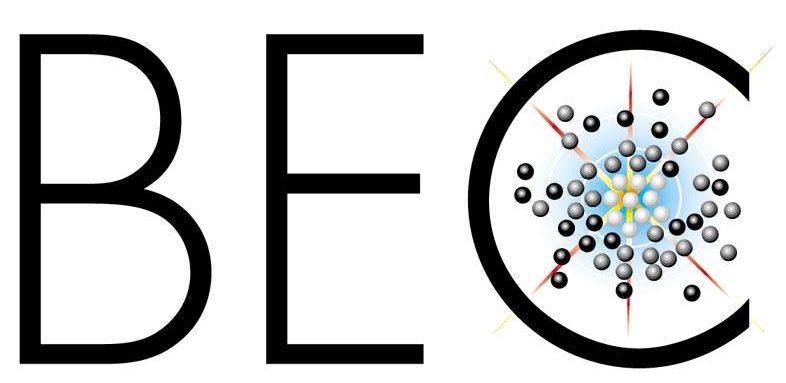
Pitaevskii Center on Bose-Einstein Condensation
Trento, Italy
Experiments with ultracold atoms

Principal investigators:
PostDoc
PhD students:
Recent PhD theses:
- Anna Berti (2024) Simulation of curved-space quantum field theories with two-component Bose-Einstein condensates: from black-hole physics to cosmology
- Riccardo Cominotti (2023) Experiments with Coherently-Coupled Bose-Einstein condensates: from magnetism to cosmology
- Louise Wolswijk (2022), Equilibrium and out-of-equilibrium physics of Bose gases at finite temperature
- Arturo Farolfi (2021), Spin dynamics in two-component Bose-Einstein condensates
- Carmelo Mordini (2020), Measurement of the density profile of quantized vortices and of the equation of state in a 3D interacting Bose gas"
- Matteo Barbiero (2019), "Novel techniques for a Strontium Optical Lattice Clock"
- Giacomo Colzi (2018), A new apparatus to simulate fundamental interactions with ultracold atoms"
- Eleonora Fava (2018), "Static and dynamics properties of a miscible two-component Bose-Einstein condensate"
- Simone Serafini (2017), "Dynamics of Vortices and their Interactions in Bose-Einstein Condensates"
- Simone Donadello (2016), "Observation of the Kibble-Zurek mechanism in a bosonic gas"
WORK WITH US: Students are welcome to join us and work in the lab on any of the ongoing research activities
Here more infos
Q-Fielbs ERC Advanced Grant

"Quantum fields in and out of equilibrium via spinor Bose-Einstein condensates ".
Press Room UniTN,
UniTN Magazine,
Quotidiano "Il T",
linkedin",
La voce del Trentino.
IMMISCIBLE TWO-COMPONENT CONDENSATES
False Vacuum Decay
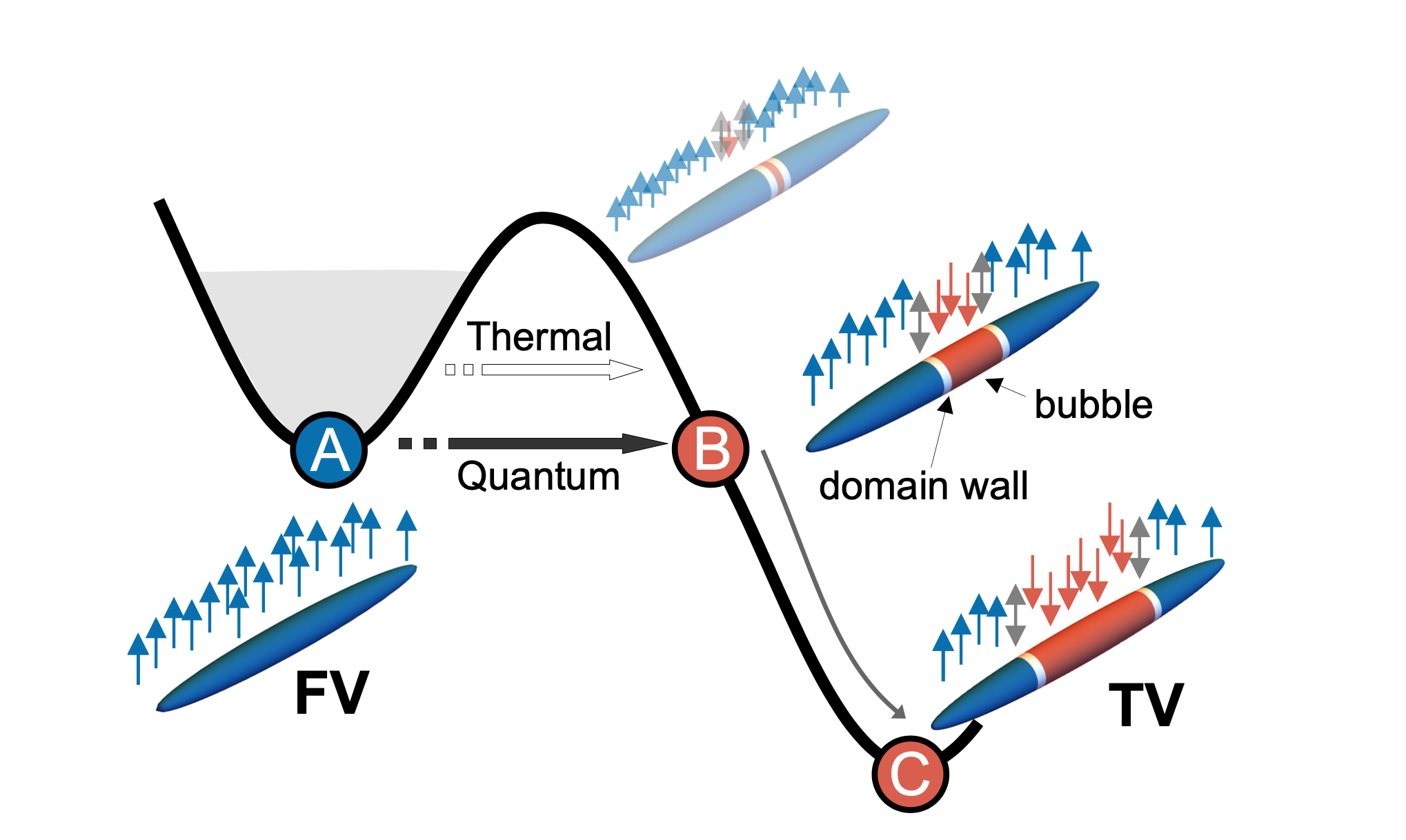
In quantum field theory, the decay of an extended metastable state into the real ground state is known as "false vacuum decay" and it takes place via the nucleation of spatially localized bubbles. Despite the large theoretical effort to estimate the nucleation rate, experimental observations were still missing. We observe bubble nucleation in isolated and highly controllable superfluid atomic systems, and we find good agreement between our results, numerical simulations and instanton theory opening the way to the emulation of out-of-equilibrium quantum field phenomena in atomic systems.
References:
False vacuum decay via bubble formation in ferromagnetic superfluids
Alessandro Zenesini, Anna Berti, Riccardo Cominotti, Chiara Rogora, Ian G. Moss, Thomas P. Billam, Iacopo Carusotto, Giacomo Lamporesi, Alessio Recati, Gabriele Ferrari
arxiv.2305.05225.
Nature Physics 20(4), 558 (2024).
Observation of Temperature Effects in False Vacuum Decay
Riccardo Cominotti, Cosetta Baroni, Chiara Rogora, Diego Andreoni, Giacomo Guarda, Giacomo Lamporesi, Gabriele Ferrari, Alessandro Zenesini.
arxiv.2504.03528.
Phys. Rev. Lett. 135, 183401 (2025).
HERE MORE ABOUT PRESS RELEASES AND MEDIA COVER.
Ferromagnetism

Quantum phase transition from a para- to a ferromagnetic state is a paradigm of phase transition. Here we study it both through experiments and mean-field calculations by exploiting a spatially extended atomic condensate in the presence of a coherent coupling between two internal spin states. The nature of the transition is assessed by looking at the phase diagram as a function of the control parameters, at hysteresis phenomena, and at the magnetic susceptibility and the magnetization fluctuations around the critical point. We are also able to deterministically generate domain walls that separate spatial regions of opposite magnetization in the ferromagnetic state.
References:
Ferromagnetism in an extended coherently-coupled atomic superfluid
Cominotti, Riccardo; Berti, Anna; Dulin, Clement; Rogora, Chiara; Lamporesi, Giacomo; Carusotto, Iacopo; Recati, Alessio; Zenesini, Alessandro; Ferrari, Gabriele
arxiv.2209.13235
Phys. Rev. X 13, 021037 (2023).
MISCIBLE TWO-COMPONENT CONDENSATES
Faraday waves

Collective excitations are a distint fingerprint of any many-body system. In our sodium mixture we are able to control their behaviour, converting them from massless to massive by adding a coherent coupling between the two involved states. We reveal their dispersion relation by generating density and spin Faraday patterns on demand.
References:
Observation of Massless and Massive Collective Excitations with Faraday Patterns in a Two-Component Superfluid
Cominotti, Riccardo; Berti, Anna; Farolfi, Arturo; Zenesini, Alessandro; Lamporesi, Giacomo; Carusotto, Iacopo; Recati, Alessio; Ferrari, G.
arxiv.2112.09880.
Phys. Rev. Lett. 128, 210401 (2022).
Quantum Torque

What happens if in the same system cohexist a region with oscillating population between two states and a region where the population is trapped in one state? This leads to the formation of magnetic interface, that get broken from the quantum spin torque, by means of the formation of a shock wave and of a strongly flcutuating regime.
References:
Quantum-torque-induced breaking of magnetic interface in ultracold gases
Arturo Farolfi, Alessandro Zenesini, Dimitris Trypogeorgos, Carmelo Mordini, Albert Gallemí, Arko Roy, Alessio Recati, Giacomo Lamporesi, and Gabriele Ferrari,
Nat. Phys. 17 (12) 1359 (2021),
arxiv.org:2011.04271,
Manipulation of an elongated internal Josephson junction of bosonic atoms
A. Farolfi, A. Zenesini, R. Cominotti, D. Trypogeorgos, A. Recati, G. Lamporesi, and G. Ferrari,
Phys. Rev. A 104 023326 (2021)
arxiv:2101.12643

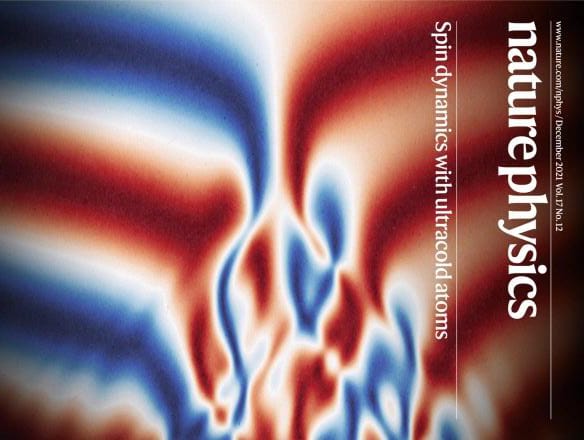
Magnetic Solitons

The ground state of a two-component miscible mixture sees the two fluids occupying the same volume with equal spatial distribution. Such a system can be excited with modulations of the total density or of the relative density. The latter are also called magnetic excitations. We produce long-living magnetic solitons in a balanced superfluid mixture of sodium and study their dynamics and collisions.
References:
Observation of magnetic solitons in two-component Bose-Einstein condensates
A. Farolfi, D. Trypogeorgos, C. Mordini, G. Lamporesi, G. Ferrari,
arxiv.org:1912.10513,
Phys. Rev. Lett. 125, 030401 (2020)
Static and dynamical properties of a miscible two-component BEC
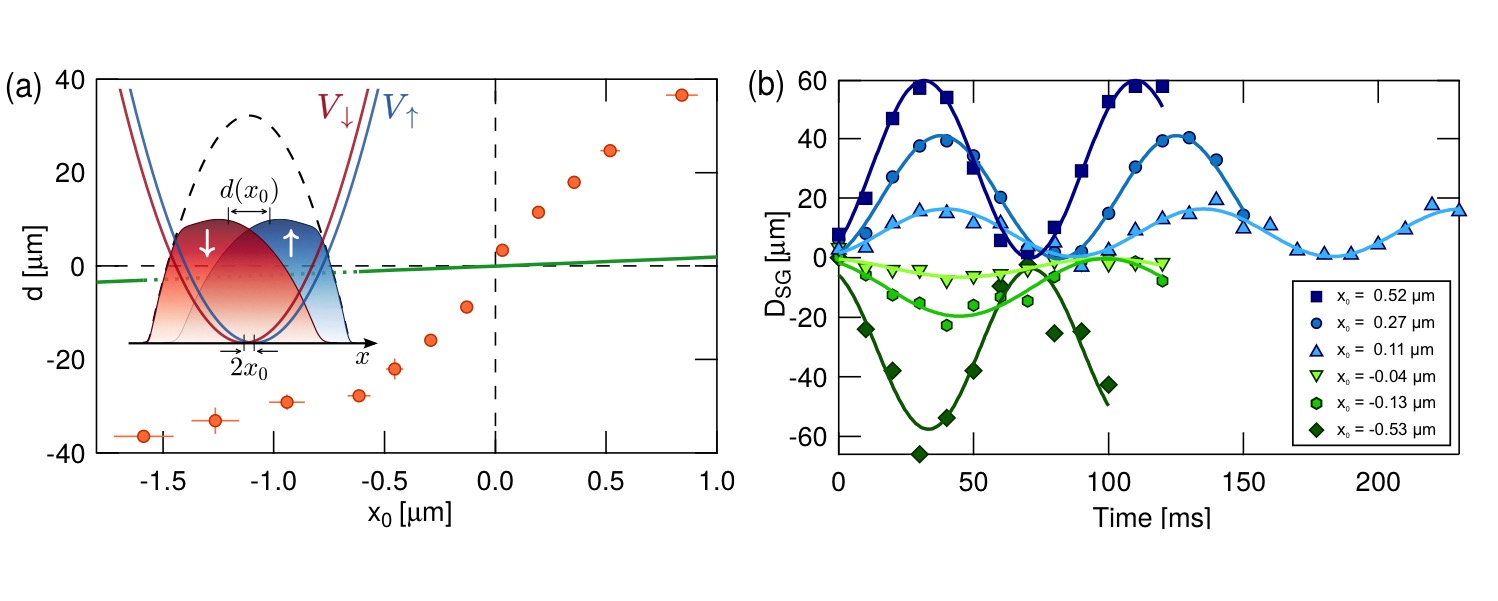
A mixture of Na atoms in the mF=1 and mF=-1 of the F=1 hyperfine state is a fully miscible mixture and thanks to the intrinsic perfect symmetry it does not show buoyancy when held in a harmonic confinement, differently from any other binary BEC studied in cold atoms. This mixture is close to the miscible/immiscible phase transition. Thanks to these nice features we are able to observe spin-dipole oscillations in the linear regime with a frequency about 5 times smaller than the trap frequency. We also measure the strong static polarizability, with an enhancement of a factor 20 in the equilibrium relative displacement of the centers of mass. These strong effects on the spin-dipole frequency and on the spin-dipole polarizability are confirmed by the theoretical predictions for a mixture near the miscible/immiscible transition. In the presence of a large thermal component the spin polarizability is even increased. At finite temperature we investigate the nontrivial dynamics of the four fluids composing the mixture and observe different behaviors for different collisional regimes. In particular, in the collisional regime the thermal components quickly damp their relative motion while the two BECs continue oscillating with negligible damping, a clear signature of spin superfluidity.
References:
Spin-Dipole Oscillation and Polarizability of a Binary Bose-Einstein Condensate near the Miscible-Immiscible Phase Transition
T. Bienaimé, E. Fava, G. Colzi, C. Mordini, S. Serafini, C. Qu, S. Stringari, G. Lamporesi and G. Ferrari,
arXiv:1607.04574,
Phys. Rev. A 94, 063652 (2016)
Observation of Spin Superfluidity in a Bose Gas Mixture
E. Fava, T. Bienaimé, C. Mordini, G. Colzi, C. Qu, S. Stringari, G. Lamporesi and G. Ferrari,
arXiv:1708.03923,
Phys. Rev. Lett. 120, 170401 (2018)
Low and Stable Magnetic Field

Long-time coherent coupling in a spin mixture can be achieved only in a very stable and well-controlled magnetic field environment. We realized a 4-layer magnetic shield that is both able to attenuate external fields by more than 5 orders of magnitude and also compatible with the presence of internal coils, that are needed to generate a known stable field on the atoms. We developed a protocols that allow to measure and compensate the magnetic field down to few microG.
Reference:
Design and characterisation of a compact magnetic shield for ultracold atomic gas experiments
A. Farolfi, D. Trypogeorgos, G. Colzi, E. Fava, G. Lamporesi and G. Ferrari,
arXiv:1907.06457
Rev. Scient. Instr.90, 115114 (2019)
Progress toward a zero-magnetic-field environment for ultracold-atom experiments
C. Rogora, R. Cominotti, C. Baroni, D. Andreoni, G. Lamporesi, A. Zenesini, G. Ferrari,
arXiv:2404.19565
PhysRevA 110 013319 (2024)
RELAQS - Quantum simulation of field theory
The goal of this project is to engineer interactions between ultracold atoms in table top experiments
to emulate and study typical phenomena of field theory and strongly correlated matter.
Most relevant example is the decay of metastable field, commonly known as False Vacuum Decay.
The power of this approach is twofold: first, the esquisite control of experimental parameters
allows a fine tuning of coupling constants and a dedicated focus on significant system observables;
secondly, the typical tools
of atomic Physics and the accessible length and energy scales allow a direct access to particle
detection and numerous atomic properties, as dynamics,
correlation function and excitation spectra.
RelaQS.
REVIEWS
Quantum mixtures of ultracold gases of neutral atoms
Cosetta Baroni, Giacomo Lamporesi, Matteo Zaccanti Nature Reviews Physics 736, 6 (2024), arXiv:2405.14562, open access file,
Ultracold atomic spin mixtures in ultrastable magnetic field environments
Riccardo Cominotti, Chiara Rogora, Alessandro Zenesini, Giacomo Lamporesi, Gabriele Ferrari, Eur. Phys. Lett. 146 , 45001 (2004) arXiv:2402.16657,
Two-component spin mixtures
Giacomo Lamporesi, arXiv:2304.03711,
IN AND OUT OF EQUILIBRIUM
Canonical EoS of a Bose gas

We use precise measurements of the density distribution of trapped atomic samples to explore the Equation of State of the uniform, weakly interacting 3D Bose gas. We developed a novel, high-dynamic range imaging method capable of imaging the atomic sample in situ with high precision both in the condensed part and in the thermal wings, whose density differ by almost two orders of magnitude. This allowed us to obtain the canonical EoS in a wide range across the transition point. We observed the dramatic deviations from the ideal Bose gas behavior caused by interactions, and provided a first observation of the non-monotonic behavior of the chemical potential with temperature, which is a consequence of the superfluid nature of the system.
Reference:
Measurement of the Canonical Equation of State of a Weakly Interacting 3D Bose Gas
C. Mordini, D. Trypogeorgos, A. Farolfi, L. Wolswijk, S. Stringari, G. Lamporesi and G. Ferrari,
arXiv:2003.13627,
Phys. Rev. Lett. 125, 150404 (2020)
Single-shot reconstruction of the density profile of a dense atomic gas
C. Mordini, D. Trypogeorgos, L. Wolswijk, G. Lamporesi and G. Ferrari,
Opt. Expr. 28, 29408 (2020)
arXiv:2005.05674,
Dynamics across Bose-Einstein condensation

Studying out-of-equilibrium dynamics or quench dynamics in cold-atom systems has become a paradigm for studying phase transitions. In this paper, we experimentally study the relaxation dynamics of a trapped ultracold Bose gas cooled across the BEC threshold. We find, among other things, a delay in the onset of condensate formation depending on the collision rate of the gas and a universal condensate growth depending only on the cooling rate.
Reference:
Measurement of the order parameter and its spatial fluctuations across Bose-Einstein condensation
Wolswijk, Louise; Mordini, Carmelo; Farolfi, Arturo; Trypogeorgos, Dimitrios; Dalfovo, Franco; Zenesini, Alessandro; Ferrari, Gabriele; Lamporesi, Giacomo
Physical Review A 105 033316 (2022)
arxiv.2201.08569.
VORTEX PHYSICS IN SUPERFLUIDS
Vortex-vortex interaction mechanisms
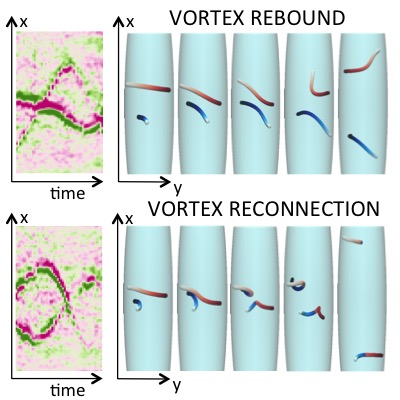
Axially symmetric elongated traps allow transverse vortices to approach with random relative velocity and orientation, differently from what happens in flat traps or in rotating condensates. We observe in real time the vortex filament orientation and position in the condensate and study different interaction mechanisms that occur depending on their approaching velocities and relative orientation.
Reference:
Vortex Reconnections and Rebounds in Trapped Atomic Bose-Einstein Condensates
S. Serafini, L. Galantucci, E. Iseni, T. Bienaimé, R.N. Bisset, C.F. Barenghi, F. Dalfovo, G. Lamporesi and G. Ferrari,
arXiv:1611.01691,
Phys. Rev. X 7, 021031 (2017)
Vortex dynamics in cigar-shaped BECs

Single vortices in elongated condensates are mainly oriented along a radial direction and tend to move on elliptical orbits around the center. We track their dynamics by performing a real-time weakly destructive imaging. The measured period verifies the predicted dependence on the local chemical potential. Whenever vortices do not lie on a radial plane but are slightly tilted, they experience a torque that forces them to precess around the long symmetry axis of the trap to conserve the angular momentum along such axis.
References:
Dynamics and Interaction of Vortex Lines in an Elongated Bose-Einstein Condensate
S. Serafini, M. Barbiero, M. Debortoli, S. Donadello, F. Larcher, F. Dalfovo, G. Lamporesi and G. Ferrari,
arXiv:1507.01511,
Phys. Rev. Lett. 115, 170402 (2015)
Observation of a Spinning Top in a Bose-Einstein Condensate
R.N. Bisset, S. Serafini, E. Iseni, M. Barbiero, T. Bienaimé, G. Lamporesi, G. Ferrari and F. Dalfovo,
arXiv:1705.09102,
Phys. Rev. A 96, 053605 (2017)
(see also Synopsis in Physics)
Solitonic vortices

The geometrical properties of a system have an influence on the nature of defects that can be supported. Besides common solitons in quasi 1D systems and vortices in round pancake like condensates, we observed solitonic vortices in elongated samples. These hybrid defects are vortices aligned along a short axis with a 2pi phase winding, but also show a planar density depletion in the radial plane containing the vortex.
References:
Observation of Solitonic Vortices in Bose-Einstein Condensates
S. Donadello, S. Serafini, M. Tylutki, L.P. Pitaevskii, F. Dalfovo, G. Lamporesi and G. Ferrari,
arXiv:1404.4237,
Phys. Rev. Lett. 113, 065302 (2014)
(see also Physics Viewpoint)
Solitonic Vortices in Bose-Einstein Condensates
M. Tylutki, S. Donadello, S. Serafini, L.P. Pitaevskii, F. Dalfovo, G. Lamporesi and G. Ferrari,
arXiv:1410.5475,
Eur. Phys. J. Special Topics 224, 473-475 (2015)
Optical visibility and core structure of vortex filaments in a bosonic superfluid
F. Dalfovo, R.N. Bisset, C. Mordini, G. Lamporesi, G. Ferrari,
arXiv:1804.03017,
J. Exp. Theor. Phys. 127, 804 (2018)
Spontaneous generation of defects

Quantum criticalities are mechanisms driving disparate phenomena ranging from the origin of our universe to the appearance of defects in uniform systems. We use ultracold atoms at the BEC transition to explore the Kibble-Zurek mechanism by directly observing the creation of phase defects in the order parameter of a Bose-Einstein condensate for temperature quenched BECs of sodium atoms.
References:
Spontaneous creation of Kibble-Zurek solitons in a Bose-Einstein condensate
G. Lamporesi, S. Donadello, S. Serafini, F. Dalfovo and G. Ferrari,
arXiv:1306.4523,
Nat. Phys. 9, 656 (2013)
Creation and counting of defects in a temperature-quenched Bose-Einstein condensate
S. Donadello, S. Serafini, T. Bienaimé, F. Dalfovo, G. Lamporesi, and G. Ferrari,
arXiv:1605.02982,
Phys. Rev. A 94, 023628 (2016)
Dynamical equilibration across a quenched phase transition in a trapped quantum gas
I.-K. Liu, S. Donadello, G. Lamporesi, G. Ferrari, S.-C. Gou, F. Dalfovo, N.P. Proukakis,
arXiv:1712.08074,
Commun. Phys. 1, 24 (2018)
COOLING TECHNIQUES
BEC in a hybrid trap
We produce large 23Na Bose-Einstein condensates in a hybrid trap characterized by a weak magnetic field quadrupole and a tightly focused infrared beam. The use of small magnetic field gradients makes the trap compatible with the state-of-the-art magnetic shields. By taking advantage of the deep cooling and high efficiency of gray molasses to improve the initial trap loading conditions, we produce condensates composed of as much as 7 million atoms in less than 30s.
Reference:
Production of large Bose-Einstein condensates in a magnetic-shield-compatible hybrid trap
G. Colzi, E. Fava, M. Barbiero, C. Mordini, G. Lamporesi, G. Ferrari,
arxiv:1803.08814,
Phys. Rev. A 97, 053625 (2018)
Gray Molasses cooling
We implemented a gray molasses cooling technique on a sodium precooled sample by using blue-detuned light on the D1 transition. Starting from a gas of 3x109 atoms at 350 microK our gray molasses stage allows to obtain a more degenerate sample containing 2x109 atoms at 9 microK. The final PSD is 10-4, one order of magnitude higher than the best we obtained with a molasses stage using the D2 transition.
Reference:
Sub-Doppler cooling of sodium atoms in gray molasses
G. Colzi, G. Durastante, E. Fava, S. Serafini, G. Lamporesi and G. Ferrari,
arxiv:1512.07053,
Phys. Rev. A 93, 023421 (2016)
Compact atomic source
We realized a novel, multi-species, compact cold atomic source. Permanent
magnets are used to create a 2D quadrupole magnetic field for a 2D-MOT.
Their residual field in combination with a vertical laser beam form a
compact Zeeman slower that enhances the number of trappable atoms.
Eventually cooled atoms are pushed along the 2D-MOT axis towards a 3D-MOT
cleaner chamber. This geometry also avoids hot atoms from the source
to directly reach the 3D-MOT.
A new source of cold atomic strontium is currently being developed in our lab in collaboration with INRIM (Turin) for the realization of an optical clock to be used as a frequency and time reference.
Reference:
Compact high-flux source of cold sodium atoms
G. Lamporesi, S. Donadello, S. Serafini and G. Ferrari,
arXiv:1301.6566,
Rev. Sci. Instrum. 84, 063102 (2013)
A Sideband-Enhanced Cold Atomic Source For Optical Clocks
M. Barbiero, M.G. Tarallo, D. Calonico, F. Levi, G. Lamporesi and G. Ferrari,
arXiv:1909.05810,
Phys. Rev. Applied 13, 014013 (2020)

FUNDING
- Provincia Autonoma di Trento
- Q@TN
- TIFPA-INFN (RELAQS Project)
- TIFPA-INFN (FISh Project)
- EU (QUIC Project)
- QUANTera (NAQUAS and STAQs Projects)